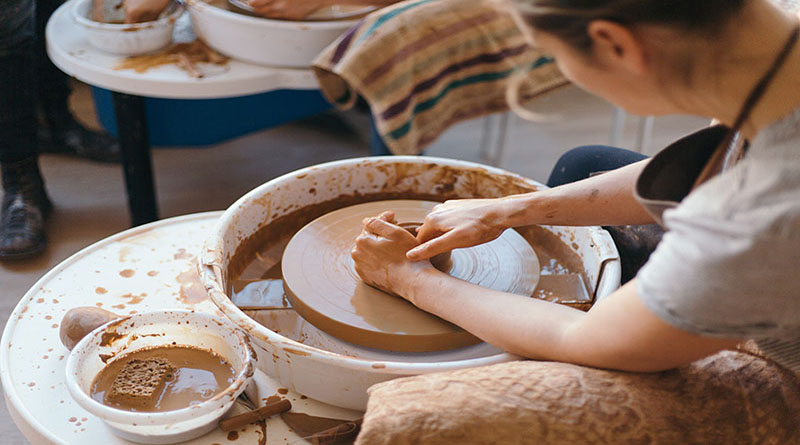By Nadine Cafaro
Ever feel the need to relax, or maybe, your friends and you are looking for something to do together, but you’re piled up in the library or have too many assignments at once? Maybe you only budgeted twenty dollars for the week and feel the intense need to throw in the towel and slam your textbook down. If this sounds like you, ceramics is a manageable hobby. Students can take a break from homework and paint, mold, or spin for a few hours, ending up with a fun new item to put in their dorms.
Don’t know how to start? Keep reading and when you’re finished you’ll be one step closer to becoming a ceramics pro.
Figure out what kind of ceramics you’re interested in
First and foremost, the distinction between creating ceramics out of clay and painting pre-made ceramics has to be made. Do you want to create a vase yourself, paint a vase someone else made or combine the two? Either way, a good start is to pick which course of action is most ideal for you.
If painting sounds like a better idea, hop in the car and head to a walk-in ceramics shop such as Uptiquing in Pine Bush or Potter’s Party in New Windsor. Both offer walk-in ceramics with everything included, from the glazes (thin, transparent colored paint) to the firing. Ceramics at these places can be as low as $10. The process is also easy; you walk in, pick a ceramics piece and glazes, pay and then paint for as long as you desire. If you’re struggling with balancing time, they also offer the option to leave your piece unfinished and come back. Danielle Grabeklis, owner of Uptiquing, offers free coffee and popcorn along with a sale box on the front counter. Hello, $2 pieces.
Now, if clay is more up your alley and you’re interested in making your own ceramics, there are many routes to go.
Use the Internet
Michael Humphreys, a ceramics professor at SUNY New Paltz, highly recommends watching videos to learn. “Youtube has beginning ceramics which can teach you absolutely everything you need to know,” says Humphreys. For example, this video teaches you how to paint a ceramic bowl with no prior skills necessary. If a bowl isn’t the desired finished product, there are multiple shapes and objects to choose from. After watching some videos, you should be going to a store or two. Basic ceramic supplies start at $5, going up in price as the quality rises. Locally, Manny’s Art Supplies sells clay, smocks, pottery and sculpting tools for your needs (and college students get 20% off).

Go to a class
If you’re more into face-to-face guidance, multiple places offer guided classes. For instance, any student at SUNY New Paltz can take Intro to Ceramics (ARS110). The class is open to all majors and even serves as a general education satisfaction. However, there is a lab fee for the equipment needed. Humphreys said it costs $110, but the materials are open to you the remainder of the semester. See https://www.newpaltz.edu/ceramics/facilities.html for the extensive list of equipment. If you’d rather go outside of campus for a class, Art Centro, a community art center in Poughkeepsie, offers different types of ceramics class for a fee. Some are more expensive than others, but you get to keep the piece and learn how to sculpt all at once. If tight on time, they offer classes on multiple days at different times.
Mary Madden, a former senior researcher at Pew Research, recommends going to classes and supplementing them with youtube videos. That’s the best of both worlds.
What you will need
Firing is heating a clay object in a kiln to a specific temperature. It’s how you turn soft clay into hard decor. However, don’t sweat the giant kiln that you’ll need to fire your pieces. Humphreys says that most pottery stores will fire your pieces for you, some at no charge. So, simply look for aprons, towels, sponges, scrapers, potters needles, throwing sticks and glazes. If you’re taking a class, these will be on hand, but if doing it from home, you may want to visit a local store or go to amazon.com. They have pottery tool kits starting at $15. Be careful and make sure to follow all the steps before firing your own pieces, as Phillip Rawson, author of “Ceramics” warns readers that “an unsuccessful firing can result in the loss of weeks of hard, perhaps inspired work.” So, maybe take Humphrey’s advice and leave the firing to a professional.
So, what are you waiting for? Get to it, and enjoy your new hobby that Grabeklis describes as “affordable and relaxing.” You can now decorate your dorm with a colorful plate and mug, this time made by you.
Check out more interesting tutorials about living in college here.
Annemarie Durkin offers advice about how to find the major that is just right for you.
Joseph Juste explores an alternate career path and how to become your own boss.
Taylor Dowd shows us a few tricks on how to succeed at managing stress.
Devon DeGroat gives us some helpful tips on how to eat healthy while away at college.
Kelsey Fredricks points out a few ways to kickstart your career while still in college.
Nikki Donohue shares how easy and important it is to become a politically active college student.
Emily Harter gets real about how to get the three P’s: the perfect pregame playlist.
Emily Fego shows the benefits of mindful eating when you go away to school.
Brandon Whiting shows how easy and accessible studying abroad actually is.
Brian Rice offers some great information about why you should be avoiding all-nighters.
Jake Mauriello offers tips to help stay organized in school.
